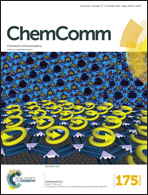A selective and sensitive near-infrared fluorescent probe for acetylcholinesterase imaging†
Abstract
Two near infra-red (NIR) fluorescent probes HupNIR1 and HupNIR2 based on the huprine scaffold and cyanine 5.0 dye have been synthesised and evaluated in situ for the detection of acetylcholinesterases in different tissues. As anticipated by the initial properties of huprine, both probes displayed a high affinity and selectivity for AChE toward BChE, with IC50 values in the nanomolar range and without any non-specific binding in the tissues. HupNIR2 appears the best probe for AChE with a great selectivity and sensitivity for AChE even in the brain region displaying a low AChE concentration as striatum. Moreover, the binding of HupNIR2 is affected when AChE is inhibited with toxic molecules such as organophosphates. This work provides a new tool to visualize active AChE in biological applications.


 Please wait while we load your content...
Please wait while we load your content...